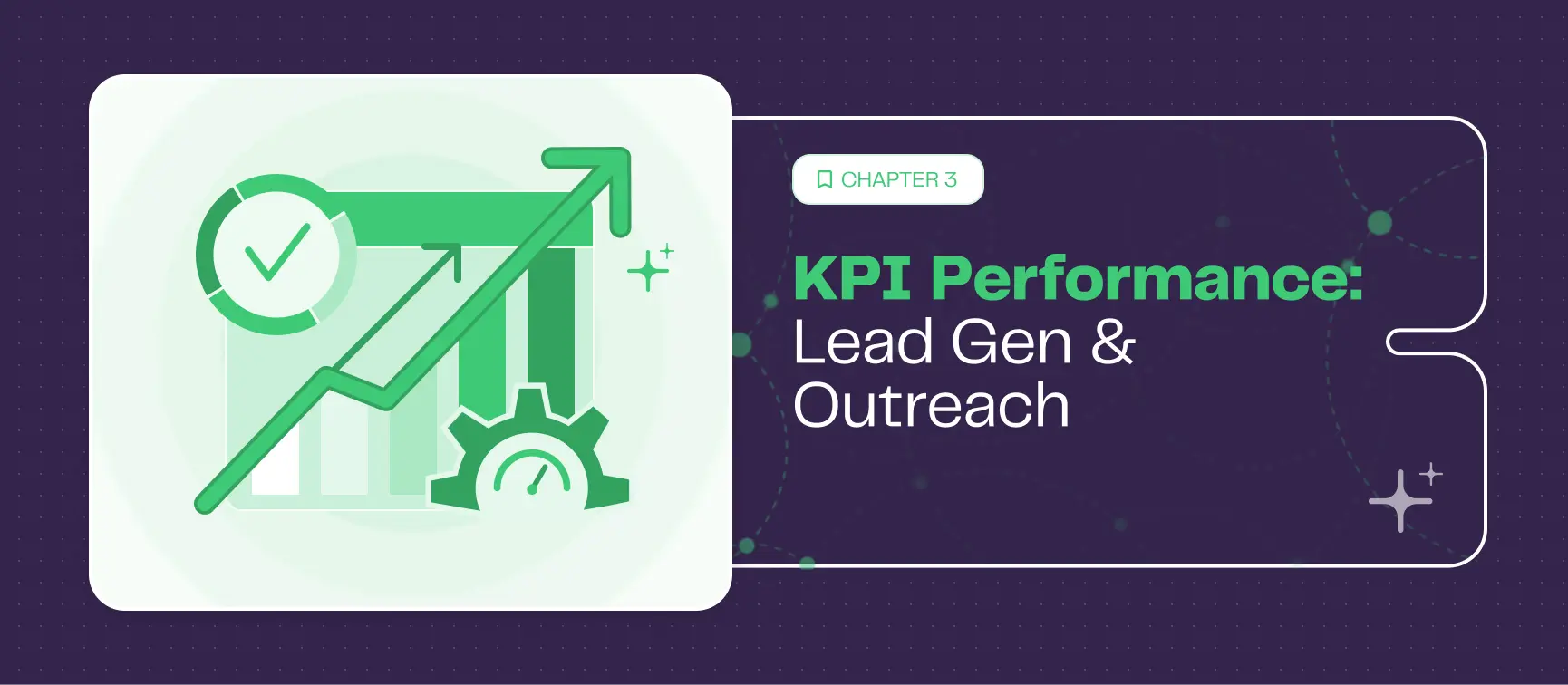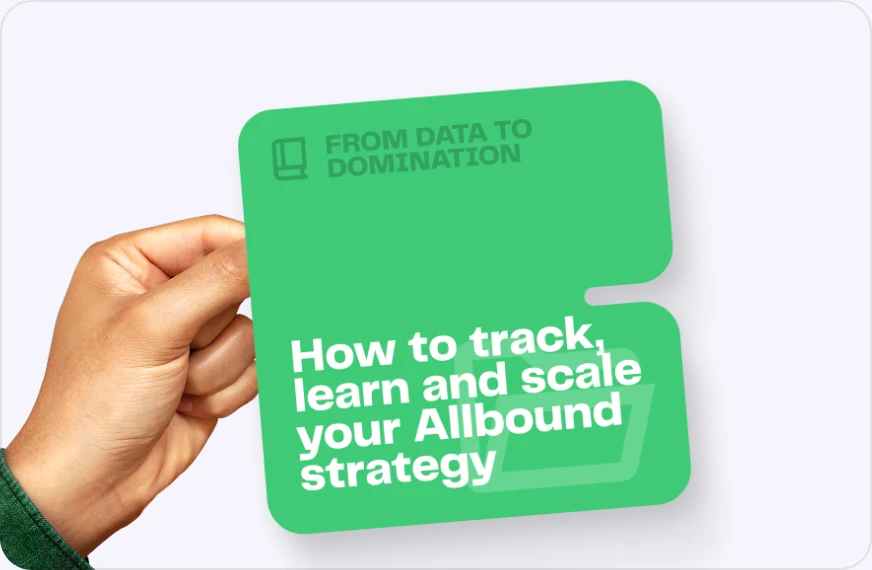
Content isn’t “nice to have.” It’s not a branding exercise. It’s not a vanity game. In Allbound, content is your most scalable salesperson, and if you’re not measuring what it’s doing for your funnel, you’re flying blind.
Here’s the brutal truth: most teams still measure content like 2016. Pageviews. Likes. Shares. And then they wonder why their pipeline looks like a desert in July.
Allbound flips that. You’re not creating content to be read—you’re creating it to:
- Generate awareness
- Convert leads
- Nurture prospects
- And close the pipeline
That means your content needs to be tracked like a revenue-driving channel, not a dusty blog archive.
So, let’s talk about KPIs—not fluffy ones, but the ones that show you what’s working, where it’s breaking, and what to scale next.
Part I - Your content KPIs
1. Lead magnet conversion rate
What it tells you: Is your content pulling its weight as a lead gen machine? You’re giving something away—a guide, a checklist, a template—and expecting people to raise their hands. Are they? If your lead magnet isn’t converting, it’s not a growth asset. It’s a diary entry.
What’s “good”?
- Below 1.5%: red flag
- 3%: solid
- 5%+: keep feeding that beast
How to track:
- Google Analytics 4 + Tag Manager
- CRM or CDP
- Segment-based attribution to see what content pulls which personas
2. Average reading time
What it tells you: Is your content resonating, or are people rage-bouncing in 20 seconds? Time-on-page is a proxy for trust. And trust is what powers Allbound’s growth. No trust, no response. No response, no revenue.
What’s strong?
- Over 4 minutes: you’ve got attention
- Under 2 minutes: your hook or formatting isn’t working
How to track:
- GA4
- Hotjar / Microsoft Clarity (for scroll heatmaps & dead zones)
Pro tip: Overlay timestamps with conversion points. See what they saw before they signed up.
3. Qualified social sharing rate
What it tells you: Are the right people sharing your stuff?
Not your coworkers. Not bots. We’re talking CMOs reposting your funnel teardown or SDRs dropping your post in a cold email. This is virality with buying power.
How to track:
- LinkedIn analytics: filter by industry, seniority
- LGM API + CRM mapping: check who shared and where they are in your funnel
- Bonus: trigger Slack alerts when a Tier 1 account engages
4. Content journey progression rate
What it tells you: Are your leads bingeing your content or ghosting after the first touch?
Leads that consume 3+ pieces of content are statistically more likely to:
- Book a call
- Convert faster
- Churn less
Formula:
(Leads who consumed ≥ 3 content pieces / Total leads) × 100
Benchmarks:
- 15–25%: Solid content engine
- 30%+: You’ve got a content loop that sells while you sleep
How to track:
- CRM + marketing automation (cookies, sessions, timestamps)
- Build “content paths” like Playbook → Webinar → Case Study → Booked call
5. Commercial impact ratio
What it tells you: Is content driving sales conversations? If no prospect ever says, “Hey, I read your post on X…” then your content isn’t landing where it needs to.
Formula: (Opportunities mentioning content / Total content-sourced leads) × 100
This number separates marketers who write from those who drive the pipeline.
How to track:
- CRM call notes or deal intelligence
- Sales enablement feedback loop
- Attribution tools + sales call transcriptions
If your content isn’t generating leads, nurturing intent, or influencing the pipeline, it’s not a growth lever. It’s noise. Track these KPIs. Build tight feedback loops. And if the data hurts, don’t panic—iterate.
Part II - Focus: LinkedIn KPIs that matter
Why should you track LinkedIn KPIs?
Social selling isn’t about posting random stuff and praying for engagement. It’s about understanding what moves the needle—and doubling down on it. LinkedIn isn’t just a content channel. It’s a diagnostic tool. Done right, it tells you:
- Who’s in your audience
- What they care about
- Where do they drop off
- What gets them to click, comment… or convert
And yet, most teams still look at vanity metrics like “Impressions” and call it insight.
Let’s fix that. Here are the LinkedIn KPIs that matter if you’re running a serious Allbound operation and what they tell you about the health of your strategy.
1. % of ICP followers
What it tells you: Are you building the right audience or just inflating your follower count?
More followers aren’t the goal. More qualified followers are. This KPI shows whether your content and targeting attract your ICP or random marketers from unrelated verticals.
How to track it:
- Go to Analytics > Followers
- Filter by timeframe: last 2 weeks, 1 month, 6 months
- Track growth rate by job title, industry, and seniority
Formula: New ICP followers / Total new followers (for a given timeframe)
If that number’s low, your content is misaligned. Is it rising steadily? Your Allbound content is speaking to the right crowd.
2. Follower demographics
What it tells you: Are you talking to decision-makers or interns?
Dig into location, industry, and job titles: this is where strategy meets segmentation. Your content is landing in unexpected sectors. Good! Use that to pivot messaging or explore new verticals.
You’ll also get cues on:
- What language to write in
- What tone resonates (executive vs. tactical)
- When to post (based on time zones)
Not sexy, but essential.
3. Visitors and reach
What it tells you: How many people visit your page, and are they returning? This is the top of your LinkedIn funnel. And it often gets ignored.
If your content’s hitting, you’ll see steady increases in:
- Unique visitors (new exposure)
- Returning visitors (ongoing interest)
Are you not seeing growth? If your content isn’t driving profile clicks, it’s time to fix your hooks, thumbnails, or CTAs.
Where to go: Page Analytics > Visitors tab, and compare weeks or campaigns
4. Engagement rate
What it tells you: Is your content connecting?
Here’s where we separate reach from resonance. You don’t just want eyeballs, you want action. Comments. Reposts. DMs. Anything that says, “This hit.”
Formula: (Clicks + Reactions + Comments + Shares + Follows) / Impressions
This tells you if people are scrolling… or stopping. High impressions, low engagement? Your targeting might be fine, but your content isn’t sparking interest.
What’s good?
- Under 1%: content misfire
- 2–4%: solid traction
- 5%+: amplify that post fast, double down on similar content
Bonus: Track per post and audience segment (founders vs. marketers, for example). The results might surprise you.
5. Click-through rate (CTR)
What it tells you: Did your content drive real action?
CTR is your truth serum. It cuts through vanity metrics and answers one thing: Did people care enough to click? Whether it’s a link to a lead magnet, webinar, or demo request, CTR is where interest becomes intent.
Where to track it:
- Post Analytics > Clicks + CTR per update
- Use UTMs on links to track in GA4 or your CRM
What’s good?
- 0.3–0.5%: average
- 0.8–1.5%: strong
- 2%+: bottle that CTA and use it again
6. Lead generation actions
What it tells you: Are you generating leads directly from LinkedIn or just noise?
This is where Allbound gets real. LinkedIn lets you add native lead forms to posts, events, or ads. You can also drive to an external CTA with a UTM-tagged link. Track both.
Measure:
- Form fills → from native LinkedIn forms
- Clicks + conversions → from off-platform CTAs (ebooks, trials, demos)
Plug this back into your CRM with LGM’s API to attribute every lead properly—and improve what’s converting.
Bottom line? Your LinkedIn strategy isn’t just about content. It’s a signal system.
If you’re not reading those signals, you’re wasting insights (and revenue). Track these KPIs, compare them over time, and use them to steer your messaging, audience building, and retargeting plays.
Because Allbound doesn’t live in the dark.
It learns. It adapts. And it wins.
Part III - Content-to-lead KPIs: The metrics that prove your content isn’t just fluff
1. Content-to-lead conversion rate (CTL)
What it tells you: Are people not just reading… but signing up?
This is the most direct signal that your content is pulling weight. It tracks how many readers became leads, telling you if your content is worth the scroll time.
Formula: (Number of leads generated / Total content visits) × 100
Why it matters: You might have killer thought leadership. But if no one’s entering your funnel after reading it? It’s thought leadership for your ego, not your revenue team.
This is where content shifts from “marketing” to “growth.”
How to action it:
- Segment by content type: guides vs. videos vs. blog posts
- Segment by channel: organic vs. paid vs. newsletter
- Segment by topic: Use this to double down on your highest-converting themes
What’s good?
- 1–2%: baseline
- 3–4%: solid
- 5%+: you’ve got a conversion asset, not just a post
Track it using:
- GA4 (tagged events + conversion paths)
- CRM/CDP (attribution tracking + UTM data)
- Bonus: Layer on scroll + time-on-page data for content depth insights
2. Content attribution ratio
What it tells you: Is your content influencing the pipeline or just sitting in the archives?
This is your influence signal, whether someone converted after reading or whether content played a role in the decision-making journey.
Formula: (Leads where content was first-touch or last-touch / Total leads) × 100
Why it matters: Allbound is multichannel. Leads don’t come from a single touch; they come from many.
This KPI shows how often your content starts the journey or seals the deal.
It’s the content equivalent of first-impression value + closing power.
How to action it:
- Use first-touch data to map top-of-funnel magnets
- Use last-touch data to surface high-conversion assets
- Build multi-asset nurture paths around both
Track it with:
- CRM + campaign ID logic
- Attribution tools (Segment, Dreamdata, HubSpot’s campaign tools)
- Sales feedback: ask what content gets name-dropped on calls
Watch for:
- Low attribution = wrong content or wrong distribution
- High attribution = content doing its job as a silent seller
3. Content conversion velocity
What it tells you: How long does a lead convert after their first content touch?
In B2B, speed matters—and not just for ops. Faster-moving content = warmer intent. If someone reads a guide and books a call three days later, that’s a signal. A slow burn over 6 weeks? Different nurturing play.
Metric: Average time from first content engagement to conversion
Why it matters: It reveals the momentum of your funnel—and helps you prioritize leads based on engagement recency.
How to action it:
- Break it down by persona: Are executives moving faster than ICs?
- Break it down by content type: Is your pricing guide converting faster than your blog?
- Break it down by channel: Do organic leads move faster than paid?
Benchmarks:
- 2–4 weeks is solid in B2B
- < 1 week: hot intent
- 6 weeks: slow lane, move them into nurture sequences
Track it with:
- CRM + timestamped content logs
- Marketing automation tools
- LGM campaign analytics (linked to content interaction triggers)
Takeaways
If you’re not measuring CTL, attribution, and conversion velocity, you’re guessing.
And Allbound is no place for guesswork.
Build content that works because you know it works. And when do you find your top-performing asset? Pour fuel on it. Promote it. Retarget with it. Build sequences around it.
That’s how content becomes a growth engine—not just a cost center.
In the next part, we will detail all the essential KPIs to monitor your performance.
